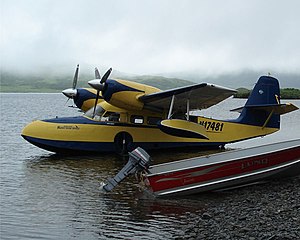SCAN 30
| G-44 Widgeon | |
|---|---|
 |
|
| A Grumman Widgeon on Frazier Lake on the southwest end of Kodiak Island, Alaska | |
| Role | Amphibious transport |
| Manufacturer | Grumman |
| First flight | 1940 |
| Primary users |
United States Navy United States Army Air Forces United States Coast Guard Royal Navy |
| Number built | 317 (including license built French SCAN 30) |
The Grumman G-44 Widgeon is a small, five-person, twin-engine amphibious aircraft. It was designated J4F by the United States Navy and Coast Guard and OA-14 by the United States Army Air Corps and United States Army Air Forces.
The Widgeon was originally designed for the civil market. It is smaller but otherwise similar to Grumman's earlier G-21 Goose, and was produced from 1941 to 1955. The aircraft was used during World War II as a small patrol and utility machine by the United States Navy, US Coast Guard and by the Royal Navy's Fleet Air Arm.
The first prototype flew in 1940, and the first production aircraft went to the United States Navy as an anti-submarine aircraft. In total, 276 were built by Grumman, including 176 for the military. During World War II, they served with the US Navy, Coast Guard, Civil Air Patrol and Army Air Force, as well as with the British Royal Navy, who gave it the service name Gosling.
On August 1, 1942, a J4F-1 flown by US Coast Guard Patrol Squadron 212 based out of Houma, Louisiana and flown by Chief Aviation Pilot Henry White spotted and attacked a German U-boat off the coast of Louisiana. White reported the submarine sunk, and he was subsequently credited with sinking U-166 and awarded the Distinguished Flying Cross.
However, in June 2001 the wreck of U-166 was found sitting near the wreck of SS Robert E. Lee by an oil exploration team; and the sinking of U-166 on July 30 (i.e. two days before the Widgeon flight) is now credited to patrol craft PC-566 escorting the Robert E. Lee.
...
Wikipedia
